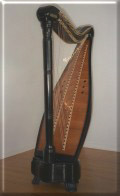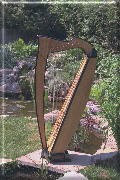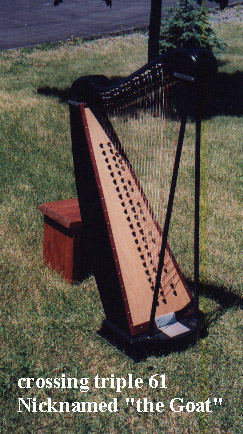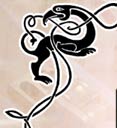Click on any
photo for a
larger version.













|

To the musical public, the image of a harp is that of an
instrument strung with one single row of strings, tuned diatonically (the
white keys of the piano) and capable of sounding accidentals (the
black keys, in the case of flats) through complex mechanical
apparatus such as pedals, sharping levers, blades or hooks or others. Mainstream harps all
have something in common: playing chromatic music demands thoughtful
planning, a trait which has traditionally placed significant
limitations on what they could do.


72 string cross strung symmetrical chromatic harp designed and built by Philippe SRL
Clement for a piano teacher in L.A. (USA). This harp features a compound
curve soundbox.


Picture of a Contemporary Cross Strung Chromatic Harp:
The Gaelic Cross 37
Designed and Built by Philippe S.R.L. Clement

The "Gaelic Cross" is a 3 octave (37 string) instrument which
provides a quasi horizontal and straight plucking line (that is
where strings are crossing), almost at
the eye level. It is perfect for the X-strung configuration, where you really
want to see what your fingers are doing. Being able to reach "all
bass and treble" strings from both hands is a fundamental feature
of the Gaelic Cross. Three octaves (37 strings) may sound short a
compass by harpers' standards... my design objectives were:
simplicity of tuning (in particular for newcomers to the harp)
and above all, the ease of reaching "all" strings from both hands.
Pragmatically speaking, 3 octaves never kept other instruments
such as the classical guitar to become wonderful interpreters of all
kinds of music, early, baroque, classical, folk, etc, and to
achieve an international profile. The Gaelic Cross is strung with
wire or nylon and can be built to receive 4 octaves. I have also
built classical looking cross strung chromatic harps up to
5 octaves (see pictures) .

The cross strung chromatic harp is different from other harps in
that it involves two rows of crossing strings. One row features
diatonic notes only, usually attached to the left side of the
soundboard; the other one features sharp notes only. The
arrangement looks like that of a piano or harpsichord keyboard
with white and black keys. Black strings on the cross strung chromatic
harp are just as easy to sound as white strings. Since the two
string plans are crossing, both hands can play the white strings
or the black strings. Since no special effort, nor apparatus are
involved in the production of accidentals, the cross strung
chromatic harp is a fully chromatic instrument, permanently tune in
the key of "C" (like a piano). From the construction point of view it is also a well balanced design,
because strings are pinned to the neck on either side (except in
the case of some Spanish Arpa de dos ordenes), the instrument has
a better string tension distribution than single rank harps. From a
musical stand point, compared to other harps, this instrument is
suitable to play a wider and more diversified repertoire, that is
virtually all string music, except when glissandi in keys other
than "C" and "C#" are required.
The playing technique for the cross strung chromatic harp
involves a distinct approach and attitude. According to Ben
Brown, a teacher and performer of this instrument (see:
"Introduction to multicourse harps" a video by Ben Brown and
Laurie Riley, available at Laurie Riley, Box 249, Vashon WA
98070) this technique involves
alternative fingering techniques (independence of
the hand, non-consecutive fingering and anticipation. Such
techniques have been described in various available methods (See Ben Brown (in English), or Odile Tackoen (in French)).
Sharp strings (which are easy to see
because they are set in groups of two (c#,d#) and three
(F#,g#,a#) and can be colour coded accordingly, are plucked with the left hand above the crossing line
and with the right hand below the crossing line.
Players of this instrument do not think that playing the cross strung chromatic harp is
more difficult than other harps. This is, I believe the opinion of professional teachers. This
view is not shared by every one, however. The cross strung
chromatic harp is based on twelve tone octaves as opposed to
seven tone octaves. In that sense the fingering may be more
complex. Comparing the cross strung harp to the ordinary diatonic harp is
a bit like saying that a piano with white keys only would be
easier to play... The object of the comparison itself is absurd.
The bottom line is that most Western music is based on the 12 tone
chromatic scale, not on the 7 tone diatonic scale, therefore, diatonic instruments
are a bit of a musical paradox, in the "big picture".
What you will need to learn in order to play the cross strung
chromatic harp is indeed a new fingering. Your fingers are used to
pluck seven strings per octave, they will have to get used to
plucking twelve strings. According to teachers, with a little
practice, this will become natural pretty quickly!
The main difference in cross strung harp fingering is that
fingers often depart from consecutive sequences:
1,2,3,4...4,3,2,1. In order to be able to reach strings above or
below the crossing line, fingers are called to pluck the strings
in a non-sequential fashion...
Whereas a "C major scale" (no sharps- would be played: 4,3,2,1,
4,3,2,1 on a cross strung harp, just as you would on an ordinary harp... a
"G major scale" (because of the situation of F#) would be played:
3,2,1, 3,2,1, 4,3 from the right hand and... 3,2,1, 4,3,2, 1,3
from the left hand. A "D major scale" would be played: 2,1,4,
3,2,1, 3,2 (RH); 3,2,1, 4,3,2, 1,3 (LH), etc.
Remember that when playing with the right hand, sharps have to be
plucked in the row below the crossing line, this is why here the
4th finger is the most appropriate to pluck F# in a G major scale! When you play with the left
hand this is the opposite, sharps are above the crossing line
and... dictate a different strategy.

Multiple course harps such as the double harp and the triple harp
are also capable of producing chromatic music without particular
mechanical devices. The double harp (see Laurie Riley's video on
this too) has two rows of parallel
strings and can be made to play chromatic music by tuning one row
of strings to the chromatic scale, while tuning the other one to
the diatonic scale. On these harps, one hand plays the chromatic
scale, whereas the other hand plays diatonic notes only. This order
cannot be switched, while playing. With the Italian Arpa Doppia
type, however, the
two rows of strings are attached to the same side of the neck and
the lateral distance between strings, which is minimal, allows
the player to reach the opposite row by sliding his-her fingers
through the strings.
A NEW BREED OF TRIPLE HARPS
Traditional triple harps are less popular than they used to be. In previous centuries they were played essentially in Wales, Ireland and Italy. Today, only a few players and builders of this instrument are still to be found in the British Isles. The triple harp is a complex instrument to play and arguably difficult to build too. It is a harp with three rows of parallel strings two that are tuned to the diatonic scale and a third one in between which is tuned to the pentatonic scale (sharps). The player plucks diatonic strings like an ordinary double harp and his fingers have to reach in between diatonic strings to sound sharps. This arrangement is not the most conducive to chromatic music playing and this may explain why the traditional triple harp has almost disappeared.
The CROSSING TRIPLE is a new approach to the triple harp. Or at least I am not aware of any precedent to its design. It is essentially a double harp (two ranks of parallel diatonic strings) with a third crossing row of sharps. i.e strings of the third row are not parallel to those of the diatonic rows as was the case of the traditional triple harp, but instead they intersect both rows of diatonic strings. In this arrangement, some sections of the sharp strings are outside the planes of diatonic strings and the player can reach them easily from both hands. This arrangement, of course, is reminiscent of the cross strung chromatic harp. I have built this instrument and I believe that the proposed string configuration could be managed by any player of multi-course harp, with a short transition.
The advantages of such a triple harp are obvious: a permanent chromatic instrument comparable to the cross strung chromatic harp and... all of the wonderful assets of the double harp...doubling the melody, splitting the melody between two hands, etc without having to lift or lower sharping levers.
As is the case for all triple harps, the main disadvantage of this instrument is the number of strings (and tuning time). The prototype (see pictures below) was built with a C2-C5 3 chromatic octaves range...that is 61 strings. With a little practice it can be managed. A four octave instrument would have 78 strings, (by-the-way) just the number of strings of the Pleyel full size Concert cross strung chromatic harp....
The construction of the CROSSING TRIPLE will be the subject of an article in the Fall Folk Harp Journal.

Arpa de dos ordenes
According to Cristina Bordas ("The Double Harp in Spain from the
16th to the 18th Centuries", in Early Music, May 1987,p 152)
formal references to the Spanish cross strung chromatic harp date back
to 1616. The Arpa de dos ordenes appears indeed to be the mother of
all cross strung chromatic harps. The Arpa de dos ordenes was a
harp equipped with two ranks of crossing strings and was created
sometime at the end of the 16th Century. According to Cristina
Bordas , (op. cit. p 148), at the dawn of the 17h Century the
cross strung chromatic harp had already "developed a separate
identity".
Cristina Bordas also states that all the surviving instruments
were made in the 17th and early 18th centuries and that they were all
built following specific rules of proportions established by the
Franciscan Pablo Nasarre. The strings (commonly gut, but
occasionally metal) were all attached from one side of the neck,
forming two rows of pins set at distinct levels. This pin level
difference was a fundamental characteristic of the Arpa de dos
ordenes; it was what would cause the strings to cross, somewhere
close to the neck and what would allow both hands to play either
the chromatic strings or the diatonic ones. The playing position
of the fingers was in the upper part of the strings, near their
crossing point. The Arpa de dos ordenes had a straight round
pillar, small holes on the sound board. The neck was thin and of
an even thickness, its harmonic curve was of a single gentle curve
type, providing a rather flat plucking line. Such harps were
built in various sizes. Some were made of walnut with a spruce
soundboard; the soundbox was of light construction, compared to
northern Europe harps, the back was reinforced with up to seven
longitudinal and up to four transversal braces. The fame of the
Arpa de dos ordenes in both liturgical and profane music peaked
at the end of the 17th century. It started declining in the 18th
century. In the second half of the 18th century it had fallen
into disuse, progressively giving way to the new pedal harp.
Today, however, historical replicas of the Nasarre based Arpa de
dos ordenes are still being built in Spain by a violero called
Pedro Llopis Areny. Mr Llopis Areny has dedicated 18 years of his
career to the research and documentation of these instruments.
His fac simile harps all follow strict historical rules of
proportions, which are the fundamental requirement for building authentical
Arpa de dos ordenes. Mr Llopis Areny builds various sizes of Arpa de
dos ordenes, up to 52 strings. The Arpa de dos ordenes is also taught
formally in Spain. In October 1996, Nuria Llopis Areny is opening
the Escuala de Arpa Espag ola which will focus on the teaching of
this wonderful instrument. (Nuria's address can be found in here).
21)
The Pleyel harp was born in Paris at the end of the 19 century.
According to the music historian Hannelore Devaere who produced
an excellent university dissertation titled: "La harpe Pleyel:
origines, construction, technique, accueil". (also available in
Dutch) Universit� de Louvain. 1988, chromaticism was becoming an
important part of the music written in that era, and this new
fashion was putting unprecedented demands on pedal harps. In
essence, the pedal harp (even the dual action type) was
experiencing some difficulty in keeping with the demand of a new
music such as that of Wagner, Liszt, D'Indy, Charpentier, Faure,
Richard Strauss and Debussy. At the turn of the 20th century,
Gustave Lyon, who was the Director of the Pleyel & Wolff Company,
manufacturing pianos in Paris, reflected on these problems and
proposed the cross stringing solution.
The cross strung configuration was adopted by Pleyel as
a means to provide for a row of sharps and a row of diatonic
strings.
These were attached on either side of a neck, widening from the
soundbox to the pillar. This setting would allow the player to
pluck diatonic notes or accidentals on either side of the neck.
The "Pleyel harp" was in fact a long series of harps in constant
evolution over thirty years. The Pleyel harp was a rather heavy
instrument, most of these harps were generally of the size of a
full size concert pedal harp. Some of them were actually heavier,
because they were equipped with a metal neck and pillar. The
strings crossed half way.
A modest number of music compositions were produced for the
instrument. The best known of these compositions is the "Danse
avec double quatuor cordes: Danse sacree, danse profane", by Claude
Debussy, 1904.
The Pleyel harp met some success in Europe at the turn of the
Century. The Pleyel Company built 930 chromatic harps until World
War Two. La "harpe chromatique" never reached the fame of the
pedal harp, as some observers of the time, and its designer Gustave
Lyon, expected. Several factors militated against the Pleyel chromatic
harp. The harpist community, instead of looking at the Pleyel
harp as a convenient alternative to play fast chromatic passages,
common in the 19th Century music, remained sceptical. Although it was in
many respects more suited to the 19th Century music than the
pedal harp, the Pleyel harp was not as versatile an instrument as
Gustave Lyon would have hoped. Because of its considerable string tension
and the great number of strings (78+) maintaining the instrument
in tune was a challenge. The volume of the instrument, perhaps
because of its heavy construction, was never as strong as the pedal
harp's. Glissandi, which is a characteristic of concert harp music could
only be executed in the key of "C" in which the chromatic harp
was always tuned. The "Harpe chromatique" remained a marginal
instrument, it was however taught in conservatories in France,
Belgium and probably Germany. Today, the Pleyel harp is still
taught formally in Belgium. Mrs Odile Tackoen, who dedicated a
lifetime to the teaching of this instrument, has published a well
thought out method called "Approche de la Harpe chromatique, son
histoire, sa technique, son r pertoire. Exercices et morceaux
divers pour d butants" 1985. In the USA, Ben Brown teaches
this instrument has produced a booklet called:" The little Cross
strung Harp Book" available at String Crossing. P.O. Box 1183
Portage MI 49081.

A wire cross-strung chromatic harp played concerts of J.S.Bach
and Richard Wagner music.
It was called the "Lute-harp"; it was designed by Gustave Lyon
around 1899 and built by Pleyel as a "special" instrument. It
retained most of the characteristics of the "Harpe Chromatique",
that is the cross-stringing configuration and the absence of
mechanical devices such as pedals, hooks or levers. Its
soundboard was however modified (hardwood). For some reason, Pleyel gave it
a twin column, although this instrument was also built with one
single column (Roslyn Rensch makes reference (in "Harps and
Harpists") to a picture of Johannes Snoer, harpist in Leipzig,
holding a small straight column wire cross-strung harp set on a
legged stand). These instruments were built much smaller than
the other Pleyel "harpes Chromatiques" and featured up to 5 octaves.
The main characteristic of the Lute-harp was that it was strung
with wire (steel) and that this feature according to its designer
was meant to provide an alternative to other string instruments such as the
harpsichord and the spinet. Gustave Lyon's idea was that the
Lute-harp would be a desirable instrument to play the harpsichord's
large musical r pertoire; work such as that of Rameau, Daquin,
Scarlatti, H ndle, Bach, etc. The Lute-harp would allow a more
subtle interpretation of this music, and in fact, would give a
complete new life to this music. In "La harpe chromatique et sa
facture" , Paris 1927, and in "La Revue Musicale", 1907, (p.
360-362).
Gustave Lyon wrote that J.S Bach's unhappiness with the
harpsichord was caused by the frail and dry sound of this instrument. Lyon
suggested that a wire strung instrument on which the strings
would be plucked from the pad (not the nail) of the finger would
provide a more melodious sound. According to Lyon's communication in "La Revue
Musicale", the first lute-harp built by pleyel was handed out to
a famous harpist called Miss Ren e L nard , who was already playing
the gut strung chromatic harp and she performed publicly four
days later. The instrument was received warmly by a prestigious
audience. One of these Lute-harps was built at the request of
Richard Wagner to accompany Beckmesser's serenade in "Die
Meister-Singer". According to R. Rensch (op.cit. p 138) harpists in this
opera orchestra often threaded paper or cloth strips through the
harp strings in an attempt to achieve the desired "cracked lute
effect". According to the correspondence addressed in 1899 by
Cosina Wagner to Gustave Lyon,
gave complete satisfaction in performances, in
Bayreuth, Paris, Mannheim, Amsterdam, The Hague, Venise and
Milan.
On other stages, the lute-harp took part in several major concert
performances, featuring, among others, the music of J.S. Bach.

|






